Eurocom Racer: Why the Radeon HD 6970M Rocks
by Jarred Walton on March 17, 2011 3:00 AM ESTMobile Sandy Bridge: Why You Don’t Need a Desktop
As usual, we’ll start with our application results. Sandy Bridge is fast on the desktop, particularly if you’re an enthusiast interested in overclocking; shift over to the mobile world and the quad-core versions are downright revolutionary. The only fly in the ointment here is that with the use of a discrete GPU and no switchable graphics, users lose access to Intel’s Quick Sync technology. I’ve been using that to encode videos for the family, and the result is several times faster than even my overclocked i7-965 system. Then again, I usually just start the encode/upload task and walk away; besides, the video editing process is far more time intensive than the encoding/uploading part, but I digress.
Here’s how the Eurocom Racer stacks up to the competition, and it’s going to look a lot like the other SNB i7-2630QM and i7-2720QM notebooks, albeit slightly faster than the former. The Eurocom results are in green, MSI's GT680R is in Red, and the Clevo P170HM is in black.
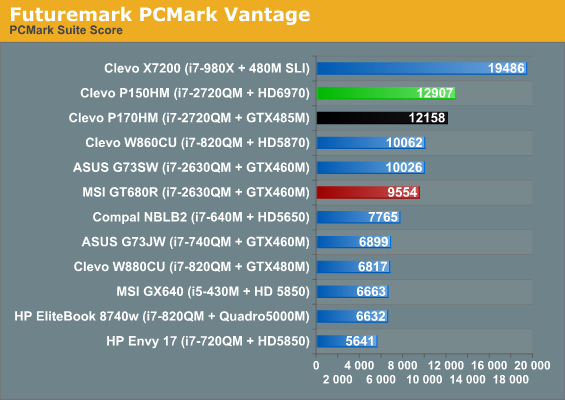
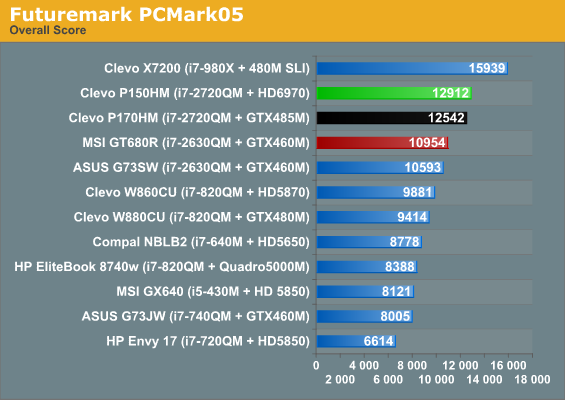
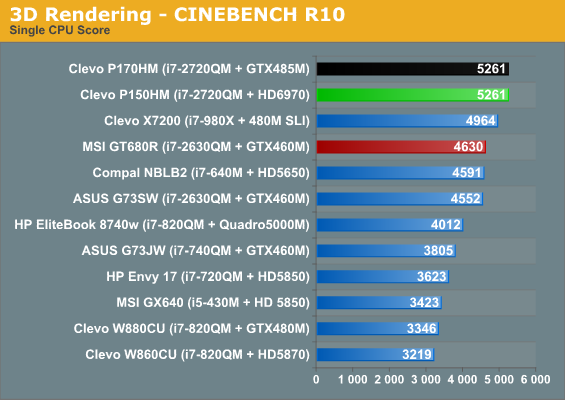
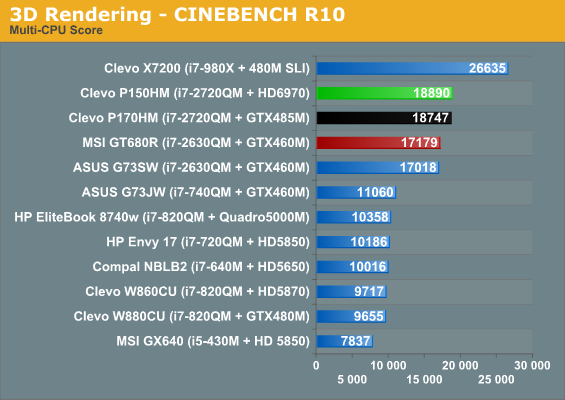
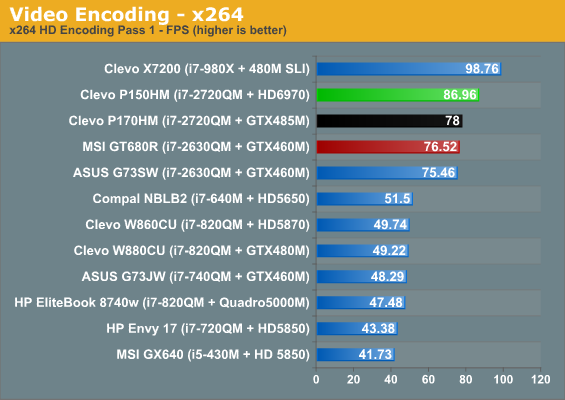
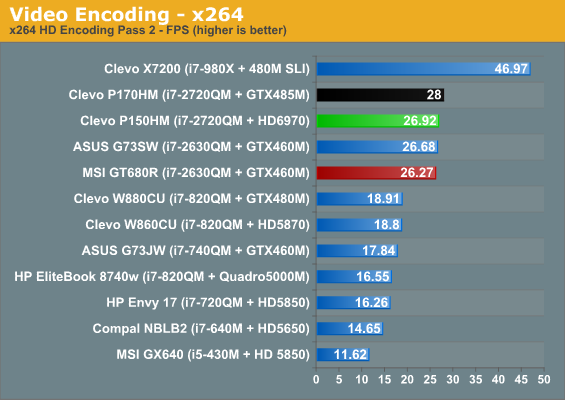
Even without an SSD, Sandy Bridge manages to pull out some impressive numbers. Interestingly, the P150HM, aka Racer, surpasses the larger P170HM in PCMark Vantage and PCMark05. How does it manage that without an SSD when the P170HM system includes a C300? Simple: it has a hybrid hard drive, the Seagate Momentus XT. Since we run PCMark (and all of our tests) more than once, the Momentus XT is able to optimize storage and put the frequently used apps into flash memory. An SSD will still be faster overall, but hybrid storage solutions can certainly close the gap and strike a nice balance of price, capacity, and performance. Now if we could just get a hybrid with more than 4GB of flash, I'd be happy.
Most of the remaining application benchmarks have the Racer and P170HM running neck and neck, though the first pass of x264 encoding shows another large margin of victory. It’s not clear if that’s another instance of the Momentus XT helping out, or if the 2720QM’s Turbo modes were just more successful in this instance, but the more intensive second pass puts things back where we’d expect. It does look to be more of the XT rather than Turbo Boost, as while the reported score is from the first of four consecutive runs (i.e. when Turbo is at its best), the worst results for x264 encoding are still 83.0 and 26.07. Let’s move on to 3DMark for a quick preview of graphics performance before we get to the actual gaming results.
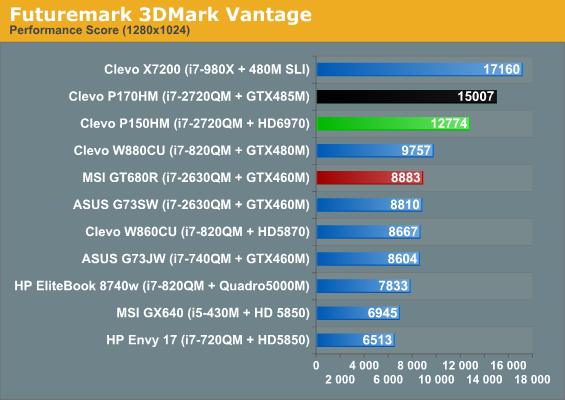

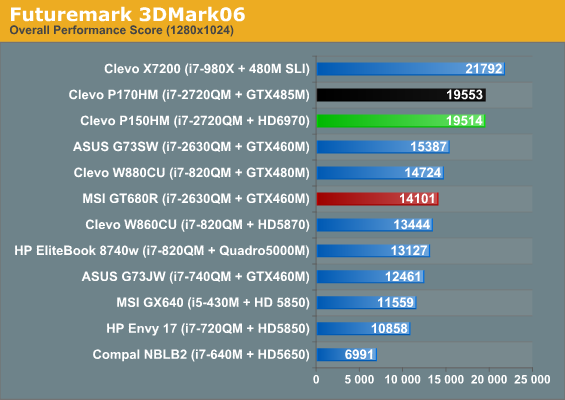
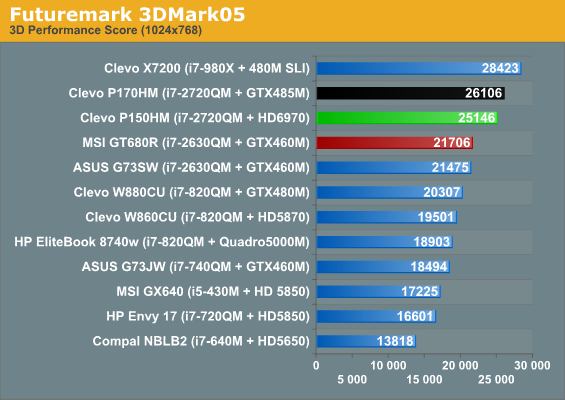
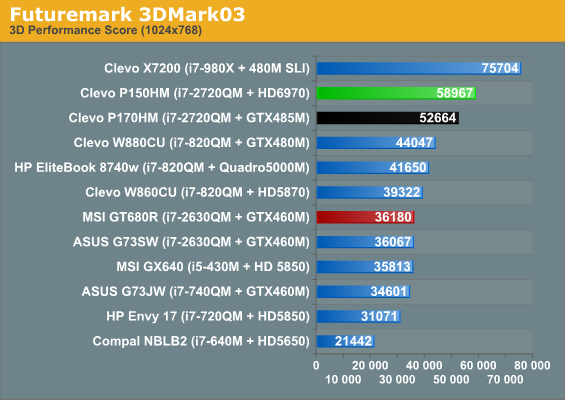
And this, folks, is why we don’t rely too heavily on 3DMark results. 3DMark almost raises more questions than answers, with the margin of victory for the GTX 485M ranging from 41% in Entry-Level Vantage to a tie in 3DMark06, and even a 12% loss in 3DMark03. We could say that gaming requirements are also variable, so just because one title happens to run well with NVIDIA doesn’t mean every title will go the same way, and that would be true. We can also throw out Entry Vantage and 3DMark03 as meaningless tests for this level of GPU; the Vantage Performance preset shows a much more reasonable 17% lead for the 485M.
On the other hand, one thing should be abundantly clear: given the apparently similar pricing, the 6970M is set to pummel the GTX 460M in most workloads. Outside of Entry Vantage and 3DMark03, the 6970M leads the fastest 460M system by at least 16% (3DMark05) and as much as 44% (Vantage Performance). But rather than guessing as to which version of 3DMark is the most meaningful for gamers, let’s just turn to some actual games.










47 Comments
View All Comments
rustycurse - Thursday, March 17, 2011 - link
Hi!to Jarred Walton:
may be i missed something (sorry for English) , but i didn't see that you ever mentioned about HDMI ( Dual-Link DVI-D, etc.) revisions and resolutions in your article. Did you ever tried to test them simultaneously (for instance: watching a movie through HDMI & playing a game through Dual-Link DVI-D, or overwise) and not only on laptop screen?
Please, do not forget about it in your next reviews. thnx
araczynski - Thursday, March 17, 2011 - link
i don't care what they put in there, with that joke of a keyboard they can keep it.AssBall - Thursday, March 17, 2011 - link
Agreed, that thing would drive me nuts. Why not just spread out the keyboard nicer and say screw the 10 key garbage? Get a USB mini addon board if you really use it that much.bhima - Thursday, March 17, 2011 - link
Good to see a decent matte screen in this Clevo. Anyone know if Anand has ever reviewed the AU Optronics B156HW01 v4? Its a FHD matte screen with 95% NTSC color gamut (I believe its the same one that is an optional upgrade for the Thinkpad W series). Some of the Clevo resellers are starting to stock this v4 screen which I believe is even better than the one in this Clevo.JarredWalton - Thursday, March 17, 2011 - link
The report on the LCD panel in this notebook specifies V1. I found a link from another site (apparently from a notebook retailer) that AUO has discontinued the B156HW01 line and is now doing B156HW02; their site only lists the B156HW03, however, so maybe they've upped the number again. They don't mention 95% NTSC anywhere, and the post saying v4 was discontinued said the newer versions were only 60% NTSC (i.e. what I tested). If you're after a wide gamut LCD, you'll want to shop around, but if all you really want is good sRGB, the B156HW01/2/3 should all work fine.Shadowmaster625 - Thursday, March 17, 2011 - link
No way that thing survives, unless you are constantly blowing out the dust.Wolfpup - Thursday, March 17, 2011 - link
It adds complexity to an already complex system, and hurts performance (presumably much more so on high end parts)-and gives me at least no benefit at all.Optimus is actually a huge NEGATIVE for me on a notebook. I quit looking at the XPS 17 when learning it used Optimus-I don't want it's decent GPU stuck behind Intel graphics.
I gave up looking at Clevos because of the drivers issues-I'd love a GTX 485...for some reason neither the GTX 460 nor 485 used in the Clevos is supported in Nvidia's drivers.
While I prefer Nvidia's drivers, it's great to see what a competitive part the 6970 is! Kind of scary that it's basically 2x the performance of the 5850 used in the previous version of the HP Envy 17, considering the core count only went from 800 to 960!
douglaswilliams - Thursday, March 17, 2011 - link
I definitely will not be making a purchase until Optimus the elusive otter shows it's head.noeldillabough - Thursday, March 17, 2011 - link
I don't need anything as fancy as full blown Optimus, but the ability to use the integrated (lower power) chip for when I'm in windows typing / webbrowsing is a must. I have the 485M and wish it could be forced off when I don't need gaming performance.idrivepie - Thursday, March 17, 2011 - link
Jarred,If you still have the notebook and are brave enough, would you be able to tear apart the notebook and check on the die of the 6970M if it says "ENG"? I'm just wondering because Eurocom has been shipping notebooks with the 6970M for sometime now, except they're shipping Engineering Sample 6970M's which a lot of customers have been pissed off by. Also, the 6970M doesn't even have an official ETA (some speculate by the end of this month) yet for its release, so how or why Eurocom would do this is questionable. If it is an ES chip, than I think it's worthy to include that in the review, because that is not something a customer would expect when buying a "new" notebook.
Thanks!